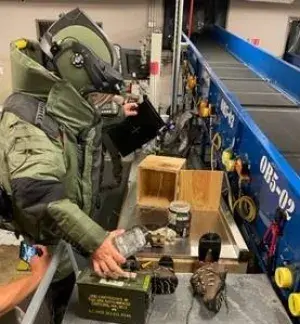 In the checked bag scenario, an integrated EOD team member in a bomb suit used a portable X-ray machine to identify and dismantle the obvious threat. (Photo courtesy of TSA RIC)
In the checked bag scenario, an integrated EOD team member in a bomb suit used a portable X-ray machine to identify and dismantle the obvious threat. (Photo courtesy of TSA RIC)
A green Kevlar® bomb suit, standard attire for anyone using a disruption tool on a suspected improvised explosive device (IED), saw action in a pair Richmond International Airport (RIC) response trainings.
In-person explosive ordnance disposal (EOD) training at RIC, the first since the start of the pandemic, gave law enforcement and TSA team members a chance to teach, coach and learn.
“Training is a great tool to build cohesion among local, state and federal law enforcement agencies and reinforce best practices,” said RIC Assistant Federal Security Director-Law Enforcement (AFSD-LE) Matthew Dyer. “These events are crucial in maintaining relationships a no-fail mission such as this demands.”
Dyer, joined by RIC Transportation Security Specialist – Explosives’ (TSS-E) Joshua Meredith and George Ingram, participated alongside the FBI, Virginia State Police, and Richmond and Henrico local police in least risk bomb location (LRBL) drills.
In the unlikely event of an onboard, inflight bomb discovery, the FAA and the airlines have specific guidelines in place to mitigate the effects of a bomb blast. Protocol includes movement by qualified flight crew of the suspected IED to a least risk location in the plane and provides guidance on proper device shielding techniques.
“In the event of a possible threat device onboard, generally a move hazard is not the way it will detonate,” said RIC Deputy AFSD-Screening Andrew Burton. “TSA trains to mitigate an LRBL because, in theory, that’s the location and the condition we would find a threat once the plane landed safely.”
“We integrated EOD teams to collaborate on response activities and test capabilities on simulated real-life threats,” said Meredith.
Another exercise included IED threat scenarios at the ticket counter, at X-ray and in checked baggage with response by fire departments and local and state police. In each instance, the possible threat was located and mitigated by an integrated team.
In the checked bag scenario, “An integrated EOD team used a specialized suit to gain access to the area and take portable X-rays to observe the interior of the box,” said Ingram. “The device was deactivated and made safe by the team.”
All of the integrated teams were debriefed on each of the scenarios.
“The close connection our AFSD-LE and TSSEs have with law enforcement is a testament to their continued dedication to a safe airport environment,” said RIC Federal Security Director Chuck Burke. “They continue to be extremely valuable assets to the entire RIC hub and spoke team.”
By Karen Robicheaux, Strategic Communications & Public Affairs


